Exemplification for foundation subjects
Religious education exemplification standards file level 2
Pupil's profile
Nishat is in Year 9 and enjoys religious education, especially when working in a small group. With support, she focuses on short tasks and develops her social skills by cooperating with others in her learning.
Evidence groups
What can we learn about and from the concept of ihsan in Islam?
Context
Pupils explored the Muslim concept of ihsan, literally 'doing the beautiful', and considered the potential impact on people's lives. In previous lessons pupils explored the beliefs and practices of Sufis through textual and audio visual material. The teacher intended the pupils to consider the impact of religion on their own and other people's lives. They talked in pairs about different areas of life where ihsan might have an impact, shared ideas about the actions that a Muslim would describe as ihsan and then recorded them in a table. Finally, they wrote a series of statements to explain the importance of these or other actions in their own lives.
Pupil's work
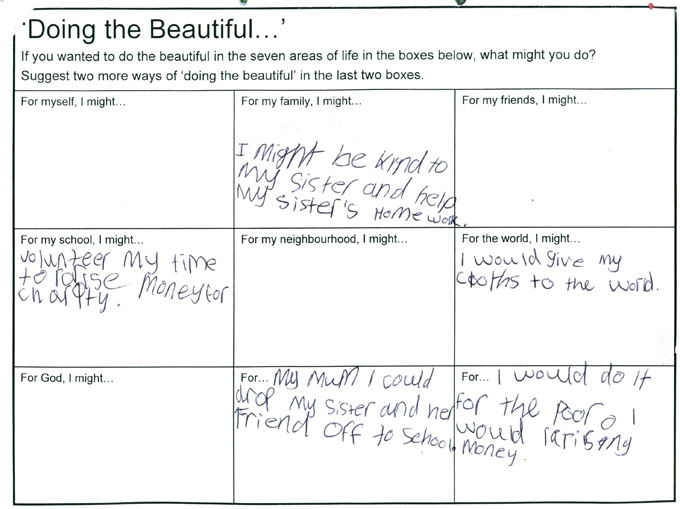
Doing the beautiful (1)
Nishat described five ways in which she might enact the concept of 'doing the beautiful'.
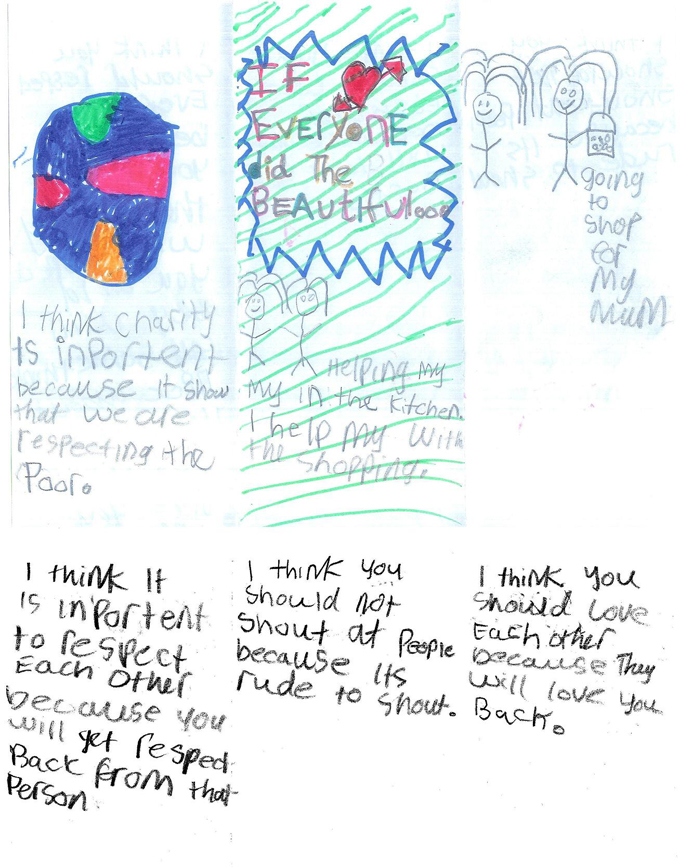
Doing the beautiful (2)
Nishat stated why she values each of these actions.
Next steps
To progress, Nishat needs to:
talk to a non-Muslim pupil to compare and contrast five things they feel are important in their lives
keep a 'doing the beautiful' diary for a week to record ways in which she has enacted this principle in her own life.
What can we find out when we compare Hindu and Muslim beliefs about God?
Context
Pupils investigated Hindu and Muslim beliefs about God by studying stories about the different gods of Hinduism and the meaning of some of the 99 names found in the Qur'an. Pupils completed a table of names and qualities of God in order to compare them. As a class they discussed the results of their investigation. This led to pupils sorting statements of belief made by young people in terms of their differences and similarities. They considered the difficulty of answering questions about beliefs.
Pupil's work

Expressing beliefs about God
Nishat used source material to identify names and qualities of God and compared them.
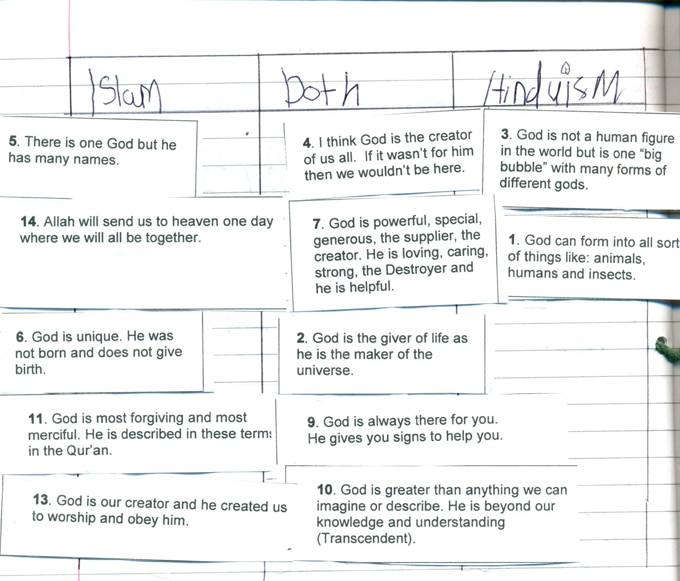
How do statements about God made by Hindu and Muslim young people compare?
Nishat completed a comparison chart to show her understanding of the different ways in which beliefs about God are expressed by Hindu and Muslim young people. She identified five ways in which these beliefs are similar.
Talking about heaven
In the context of discussing her own beliefs, Nishat explains why it is difficult to answer a question about heaven.
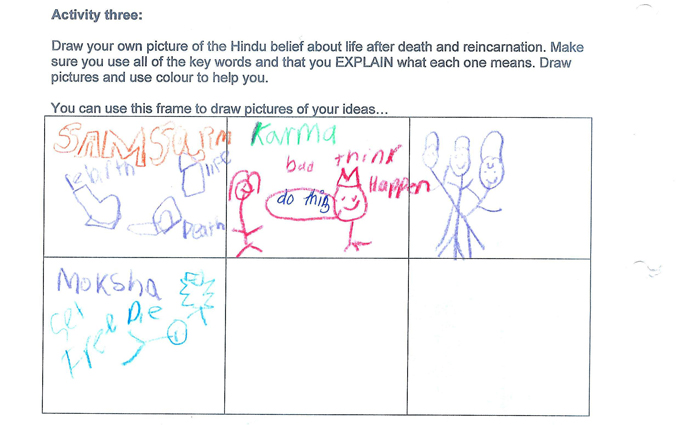
What do Hindus and others believe about life after death?
Nishat drew pictures to represent her understanding of Hindu beliefs about life after death.
Assessment commentary
Thinking about religion and belief:
Nishat identified how beliefs about God are expressed in similar and different ways by Muslim and Hindu young people. She correctly placed the phrase, 'many forms of different gods' in the column for Hinduism and the phrase 'Allah will send us to heaven one day…' in the column for Islam. She found five beliefs that appeared to be in both religions.
In discussion with the teacher, Nishat identified some different ways in which beliefs about life and death are expressed. She explained her picture of the Hindu idea that in Moksha the soul is liberated: "a person is dead and his soul like is flying off."
Enquiring, investigating and interpreting:
Nishat recognised that some questions about life, such as those about life after death, are difficult to answer. In response to the teacher's questions, Nishat explained that she did not know what heaven
is like: " …because we can't tell how heaven looks… …because we haven't been to heaven." In her drawing of a devil she showed how this represented the concept of bad and
that the idea of hell is understood by some believers as a symbol of bad.
Reflecting, evaluating and communicating:
Nishat showed her understanding of how the concept of karma is valued by Hindus by saying that good actions mean "we would get rewarded".
Next steps
To progress, Nishat needs to:
identify the impact of different forms of expression on the lives of Hindus and Muslims, for example in worship
describe and suggest meanings for symbols and other forms of religious expression which show that she understands how these beliefs are distinct from her own
make connections between different aspects of her learning, such as Hindu beliefs about karma and the cycle of life, death and rebirth.
How do Muslims and Christians express their key beliefs?
Context
This sequence of lessons aimed to help pupils appreciate the similarities and differences in the key beliefs of Islam and Christianity. The study of Islam covered Sunnis and Shi'a as well as the Sufi path. Pupils asked family members to explain a word from Islam and its importance. This became the framework for a piece of writing. The work on Christianity began with a study of the Nicene Creed.
Pupil's work
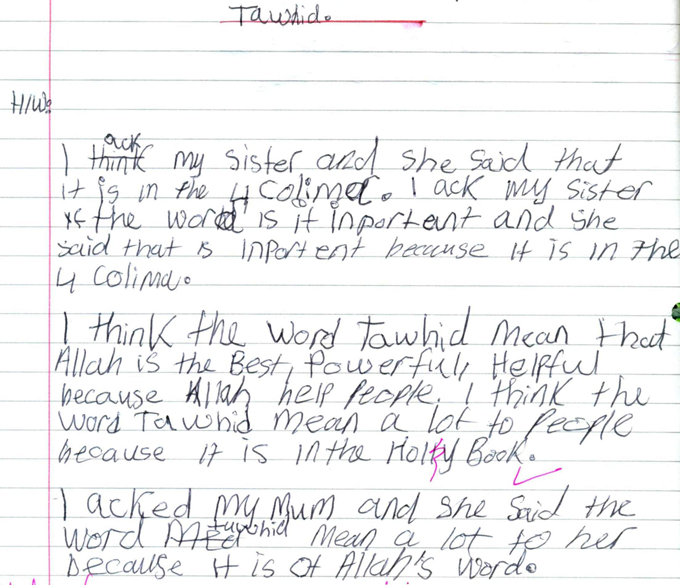
Muslim beliefs about God
Nishat asked her sister and mother to explain why the word tawhid is important. Nishat wrote what she had found out and added her ideas. When Nishat wrote 'the 4 colima' she was referring to the Kalima - the key teachings of Islam.
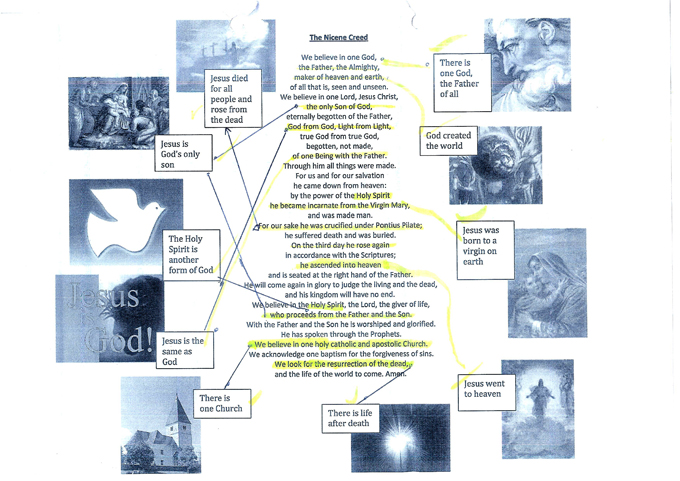
The Nicene Creed
Nishat highlighted the phrases in the Nicene Creed, linking them to the relevant images, which express some key beliefs in Christianity.
Assessment commentary
Thinking about religion and belief:
Nishat identified how some key beliefs of Christianity are expressed through the Nicene Creed. She highlighted correctly the phrases from the Creed that express each belief.
Nishat identified similarities and differences in the beliefs of the two religions when she said: "Christianity believes that Jesus is the son of God and Islam, we believe that he is a messenger of our prophet."
Enquiring, investigating and interpreting:
Nishat demonstrated that she can ask questions by interviewing her sister and mother about why they felt tawhid was important. "I asked my mum and she said the word tawhid mean a lot to her because it is Allah's word."
Reflecting, evaluating and communicating:
When asked about her own feelings about why tawhid was important, she responded sensitively and imaginatively and said: "…because Allah help people. I think the word tawhid mean a lot to people
because it is in the Holy Book."
Next steps
To progress, Nishat needs to:
broaden her knowledge and understanding of religions so that she can identify a wider range of similarities and differences between them
identify the way her own and others' beliefs have an effect on people's lives
identify what influences and inspires her and why.
Overall assessment judgement
Religious education exemplification standards file level 2
Overall, Nishat is working at level 2.
Thinking about religion and belief:
Nishat made simple comparisons of some features of three major religions: Christianity, Hinduism and Islam. She illustrated how the concept of ishan could be seen in people's actions. She identified and described beliefs about life and death and different incarnations of God. Within the different traditions she identified similarities such as being kind and good to others. When working on the Nicene Creed she talked about similarities between Christian and Muslim beliefs.
Enquiring, investigating and interpreting:
Nishat recognised that some questions are difficult to answer and gave simple reasons for this when talking with her teacher. She asked questions of her family to find out why they felt that tawhid was important and reflected on their feelings about it. She drew pictures and symbols to represent her understanding of Hindu beliefs about reincarnation.
Reflecting, evaluating and communicating:
In discussions with her teacher and in written work, Nishat responded to straightforward questions about her own and others' feelings and beliefs. She described the concept of karma and gave reasons why it is important to Hindus. She gave reasons why tawhid is valued.
The extracts of pupils work below are a reminder of some of the evidence used to make these judgements.
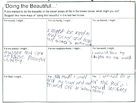
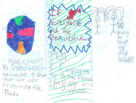
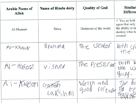
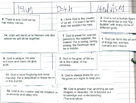

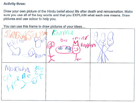

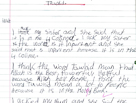
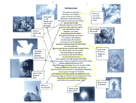
Assessment commentary
Reflecting, evaluating and communicating:
Nishat responded to questions about the concept of ihsan in terms of its impact on her own and others' experiences. She gave a reason why she values something: "I think it is important to respect each other because you will get respect back…" She also gave reasons why something might be valued by others: "I think charity is important because it shows that we are respecting the poor."